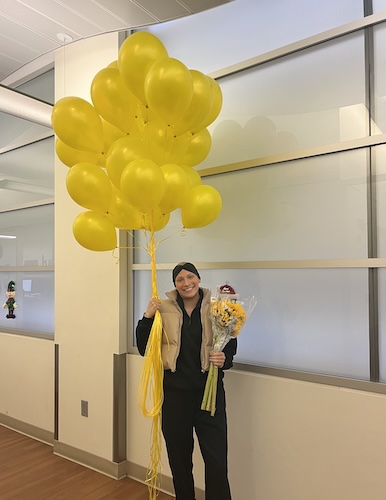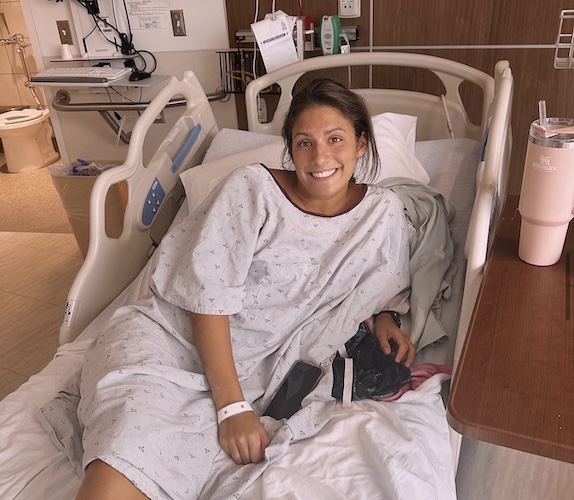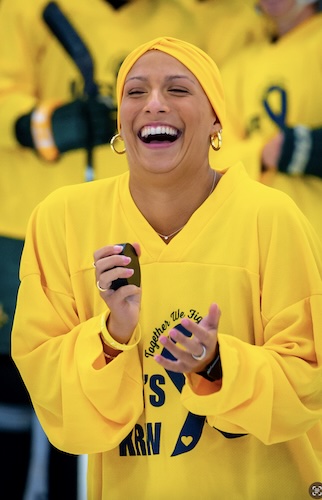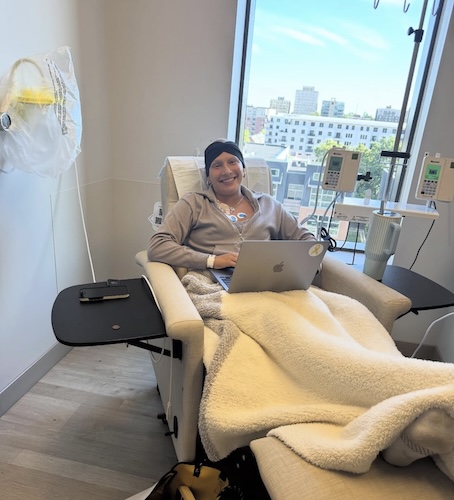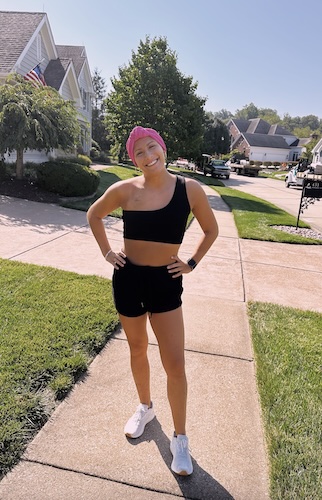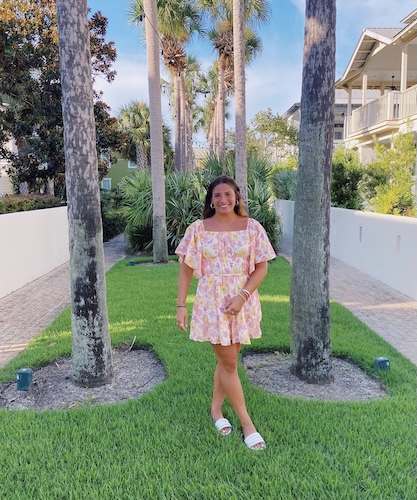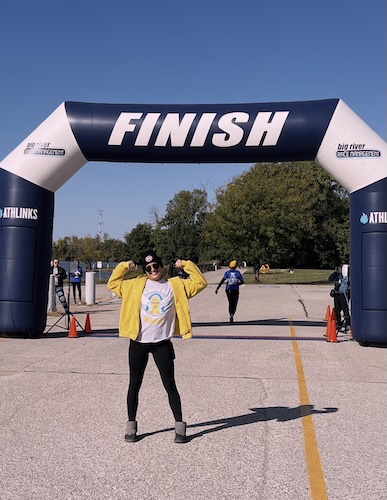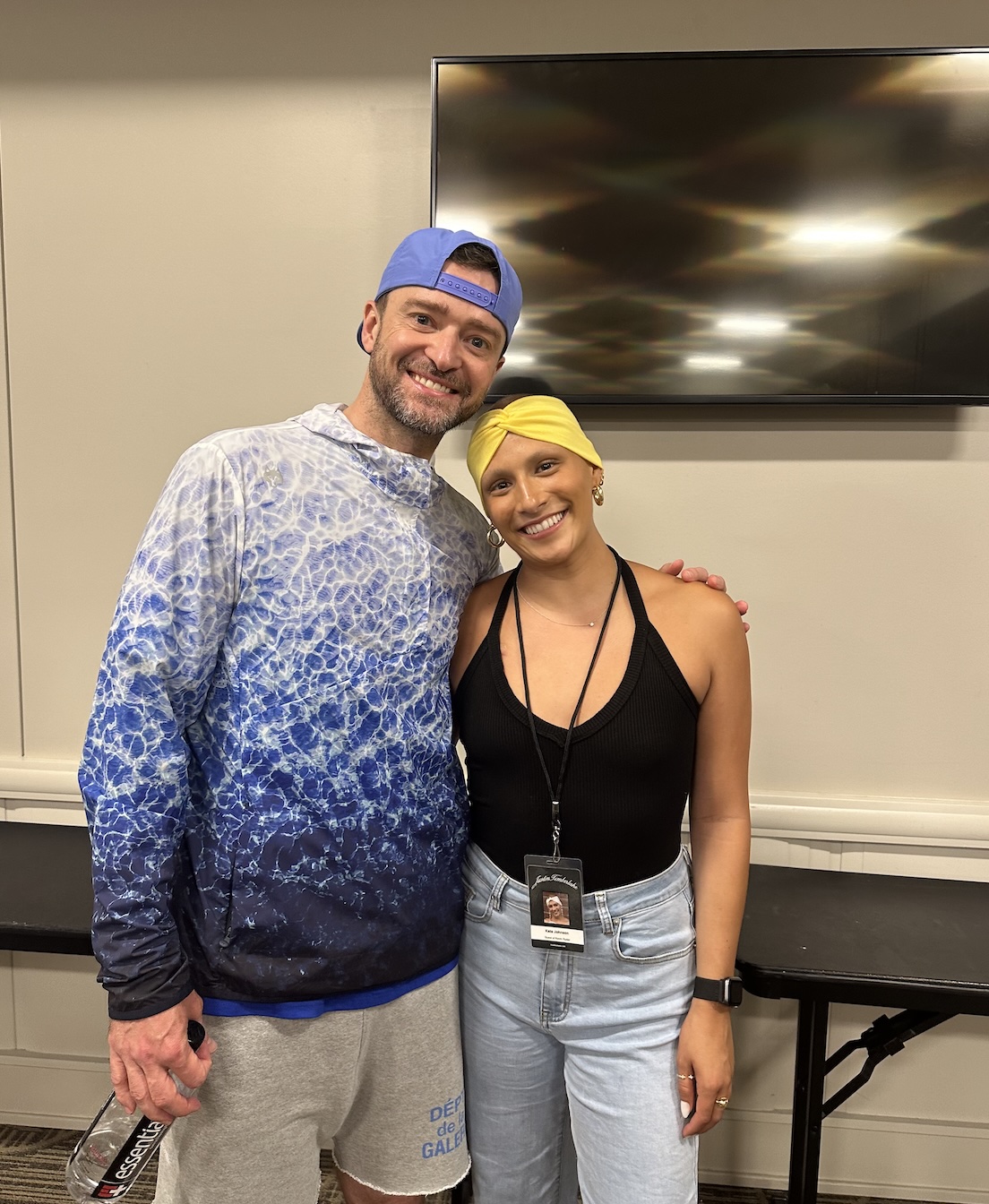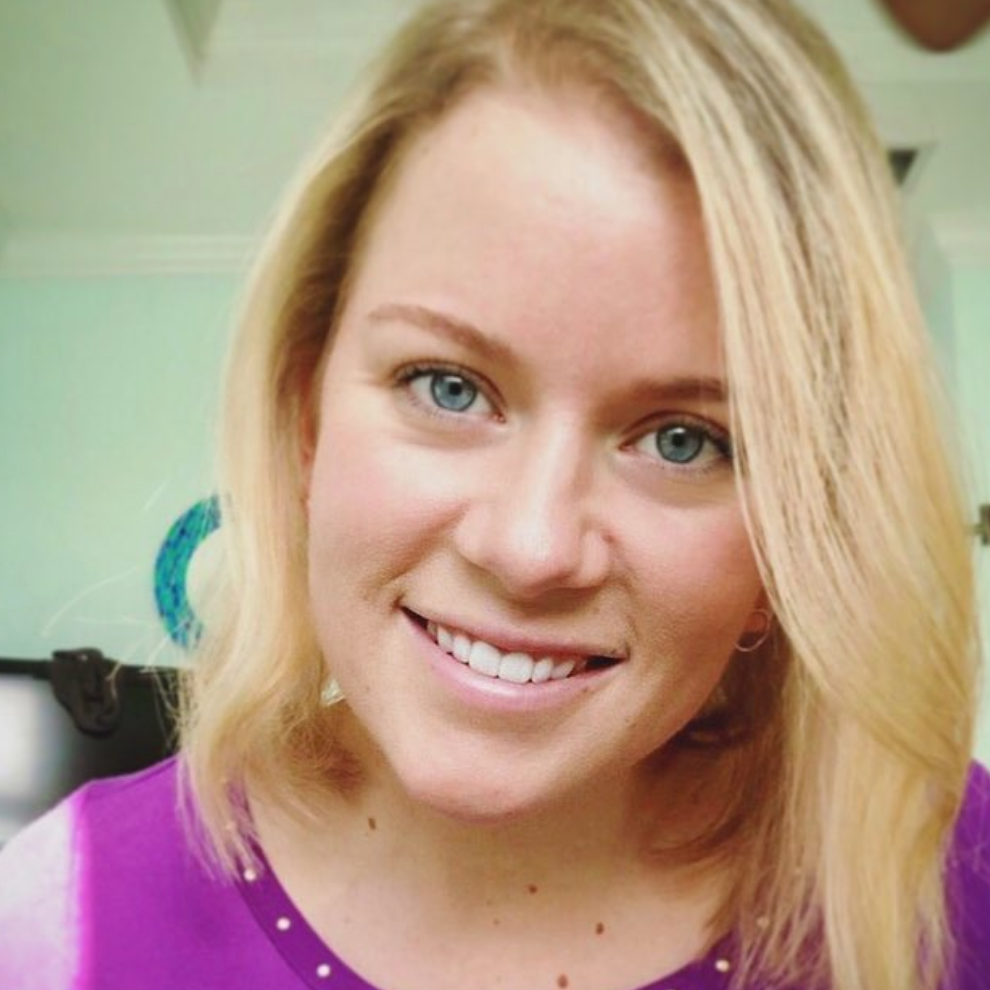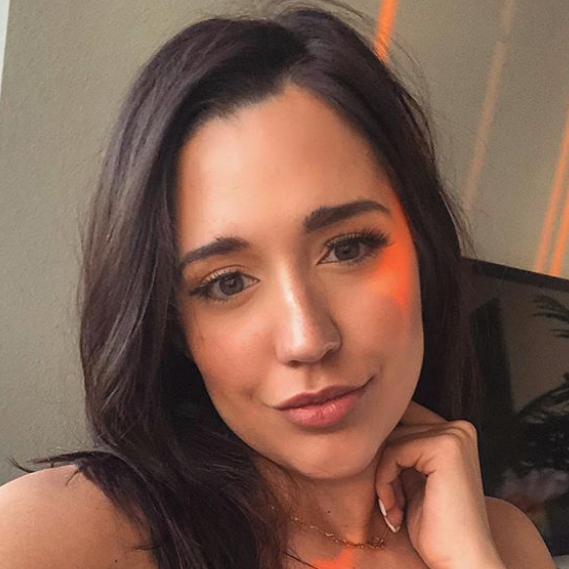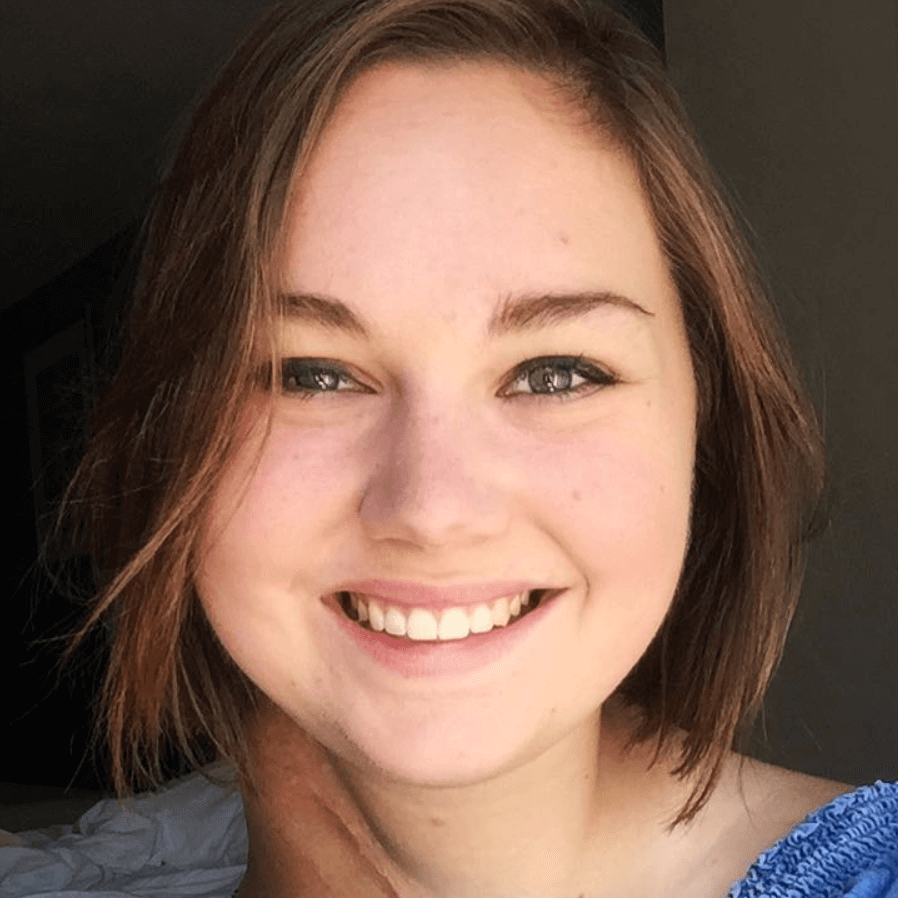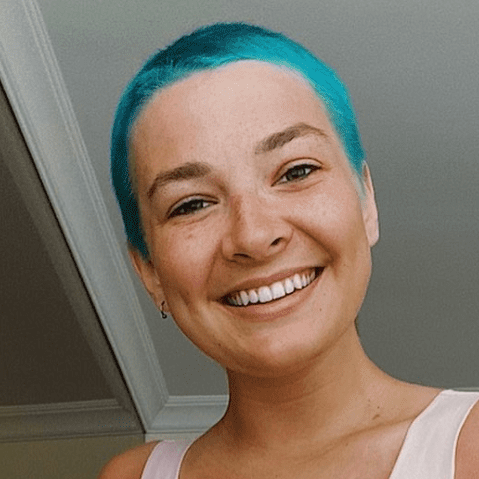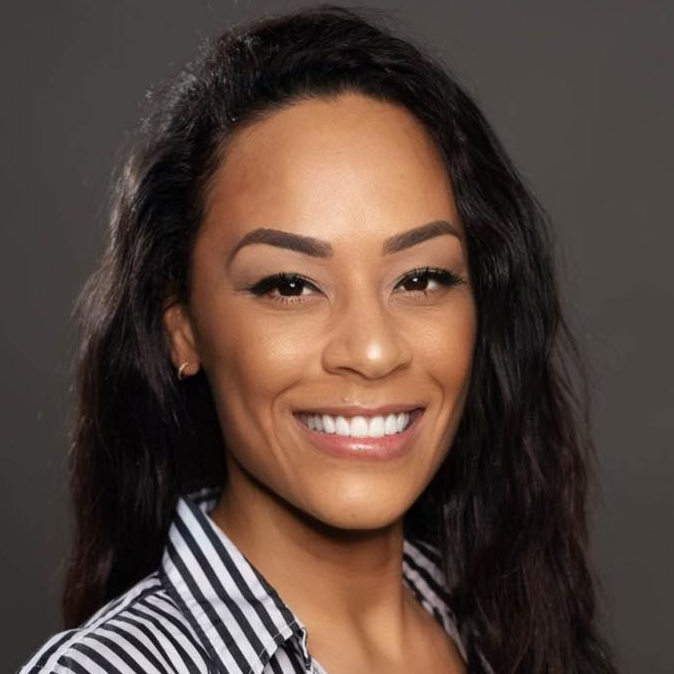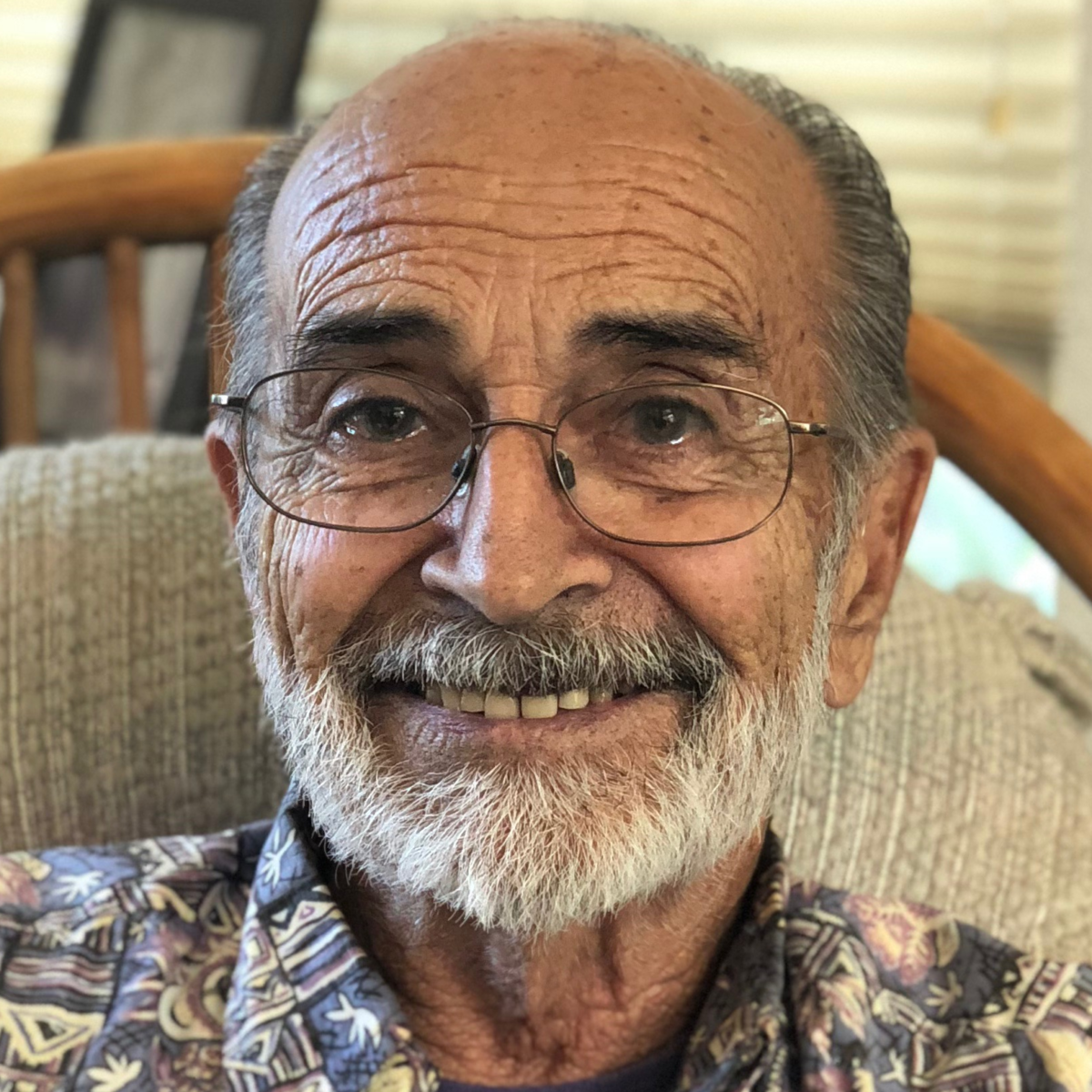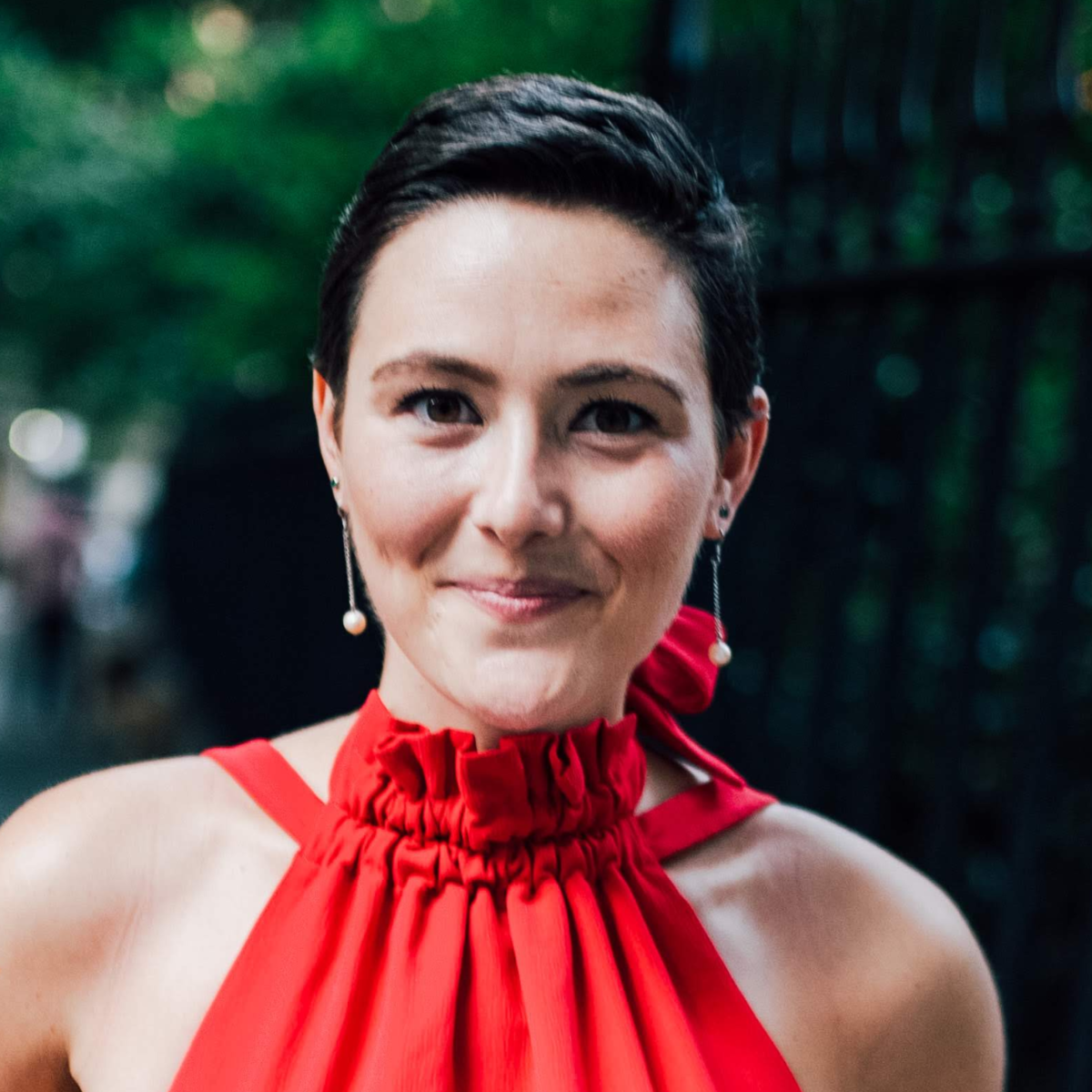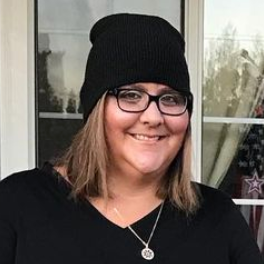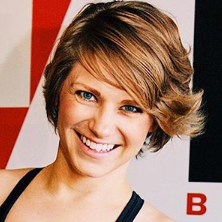Kate Navigates College and Stage 4 Rhabdomyosarcoma: A Story of Hope
Just as she was entering her sophomore year at Indiana University, Kate’s life shifted in an instant. What began as a subtle, easily dismissed ache on the lower right side of her body soon grew into something she couldn’t ignore. A series of scans and referrals brought her to Siteman Cancer Center, where she learned the diagnosis no one her age expects to hear: stage 4 rhabdomyosarcoma, a cancer commonly found in the budy’s muscles. From that moment on, everything changed. Her academic plans, her routines, and her daily life were all suddenly rewritten.
Interviewed by: Taylor Scheib
Edited by: Chris Sanchez
Supported by her family, friends, and a dedicated college community, Kate charted her rhabdomyosarcoma treatment over fifty-two weeks of chemotherapy and radiation. “My doctor told me not to take classes, but I needed something to keep my mind busy. I’m now on track to graduate on time,” she shares.

Kate’s experience was marked by learning to navigate social interactions as a sorority member post-treatment and finding motivation through small but meaningful acts of kindness. Notably, a freshman’s positive comment about her short hair and an unforgettable shoutout from Justin Timberlake in Dallas fueled her resilience.
The disease’s response to treatment shifted the path again when, after apparently successful therapy, scans revealed new cancer spots. Kate began another round of treatment, determined to reach stability even when remission seemed unlikely. Her optimism persists. “I know there’s still hope,” she affirms.
Through open dialogue about her diagnosis, forming connections with other young survivors, and fostering awareness, Kate embodies the expression, “You’re stronger than you think.” Her story is a testament to adaptability, support, and the power of patient-led advocacy for this rare kind of sarcoma.
Watch Kate’s video and read through the edited transcript of her interview below for more on how:
- Listening to your body and recognizing subtle symptoms like unexpected discomfort can be critical to early diagnosis and timely treatment
- Academic and social support can empower patients to remain connected and resilient during extensive treatment
- Small acts of kindness, such as reinforcement from peers, can profoundly impact confidence and well-being
- Treatments change and setbacks occur, but maintaining hope and adaptability fosters strength and stability
- As Kate says, it’s okay not to be okay. Every patient deserves validation, rest, and self-compassion as part of their experience
- Name: Kate J.
- Diagnosis:
- Rhabdomyosarcoma
- Age at Diagnosis:
- 20
- Staging:
- Stage 4
- Symptoms:
- Discomfort on the lower right side of the body
- Pain when sitting down
- Treatments:
- Radiation therapy
- Chemotherapy
- Immunotherapy
- Clinical trial
This interview has been edited for clarity and length. This is not medical advice. Please consult with your healthcare provider to make informed treatment decisions.
The views and opinions expressed in this interview do not necessarily reflect those of The Patient Story.
My name is Kate
I was diagnosed with stage 4 rhabdomyosarcoma in July 2023.
I’m in my senior year of college at Indiana University. I was in my freshman year before I got diagnosed. I joined a sorority that’s big on philanthropy, which I love, and we do a lot of fundraising for breast cancer.
I grew up dancing for about 15 years, from age three to 18, so I still stay connected with the dance community. I’m a triplet, with siblings who keep me going, plus an older sister who’s three years older than us. We’re a busy household with three dogs, and our home is full of life.
My first symptoms
After my freshman year, around Memorial Day weekend, I started feeling something off near the right side of my lower body. It was uncomfortable to sit down, but I thought it was something minor, like a hemorrhoid or an ingrown hair.
When I went to my doctor for a routine physical, I mentioned it. He referred me to a rectal surgeon, which sounded strange for what I was feeling. I didn’t go and instead saw an OB-GYN, who ordered a CT scan. The scan led to a referral to a gynecological oncologist, a term I didn’t even know at the time.
That appointment took a month to get, and during that time, things got worse. When I finally had a PET scan, they told me to come to the hospital immediately. I remember walking in and seeing the words “Siteman Cancer Center.” I still didn’t think it was cancer.
Then the doctor’s fellow came in and told me that I had stage 4 rhabdomyosarcoma. My first reaction was to laugh. Then I cried, after seeing my dad cry first. My mom and dad were heartbroken. I was only 20.
Later, I learned that my parents already knew the diagnosis before I did; they were told over the phone.
How I shared the news
I told my closest friends in a small group chat we call “Crazy Eight.” I didn’t want them to feel sorry for me, so I framed my message as something inspiring, our “new fight.”
The support I received was unbelievable, both from my friends and online.
I posted on Instagram and gained over 3,000 new followers in a week, all sending encouragement rather than pity.
What my treatment looked like
My treatment plan included 52 weeks of chemotherapy and radiation. The idea was to take it semester by semester. My doctor initially wanted me to take a break from school, but I wanted to keep my mind busy.
I started with general education courses and discovered I could manage them. My professors were understanding and gave me flexibility when needed.
I’ve been able to stay on track and will graduate on time.
Returning to school
I returned for my junior year after finishing treatment and rang the bell in July 2023.
Moving back into the sorority house with 100 girls in August was a culture shock, especially since I was still at high infection risk. Adjusting socially was hard, too.
Being 21, surrounded by parties, meant learning to say no. My body couldn’t handle alcohol like before.
Some people didn’t know my story, and I worried about how I looked with short hair. But a freshman told me one day, “You look beautiful; I love your haircut,” and it made my whole week.
It’s also amazing that Greek Life at Indiana University came together and raised some money to help me out. For the first time, it felt like I was finding my footing again.
The Justin Timberlake moment
One incredible experience was meeting Justin Timberlake.
I’m from a big hockey family, and my brother’s connection led to JT’s manager hearing my story. Justin filmed a personal video inviting me and my whole family to any of his tour stops.
We went to Dallas in June 2024, a month before my bell-ringing. He gave me a shoutout mid-show, saying, “She’s due to ring the bell in one month.”
He treated us like friends, asking for updates and wanting to see the ringing video.
The cancer came back
In November 2024, a scan revealed a small neck spot. Initially, my doctor thought it might be a false positive, but by December, new spots appeared. A biopsy confirmed that the cancer was back.
I restarted chemo in January, plus immunotherapy, which was new to me. When a trial drug failed, I switched back to a previous chemo regimen and added radiation. After the October 2025 scans, my doctor said this would be hard to treat and that remission might not be likely.
Still, I feel hopeful. Treatments keep evolving, and my body has always responded well. My current goal isn’t just remission. It’s stability and strength.
Navigating hope, college, and the future
I take things day by day.
My college experience looks different, but I’ve found my new normal. My friends keep me included through phone updates, and I visit when I can.
I even have an internship in the medical device industry now. The company has been flexible with my treatment schedule. They told me, “We can work with you.” That kindness made me feel like I belong.
I am a totally different person compared to who I was just two years ago, but in a good way. I’ve matured and learned a lot, and honestly, that’s what makes me glad that these things happened. I wouldn’t be who I am today if I hadn’t been diagnosed with rhabdomyosarcoma.
Being open about my diagnosis
I’ve always been open about my story. When people ask questions, even tough ones, I’d rather they learn than make assumptions.
Only once did someone cross a line, asking, “How much longer do you have to live?”
I told them, “My doctor hasn’t said anything, so as far as I know, I have as long as you do.”
How I’ve found support
My cancer is pediatric-type, but I’m treated on the adult side, so there aren’t many people my age with sarcoma. Still, I’ve met one girl who became a close friend. We both relapsed and remind each other that we can do it again.
I’ve connected with other young cancer survivors through university, social media, and across state lines.
There’s even another triplet in St. Louis who’s my age and who has a different sarcoma. It’s such a small world.
What I want people to know
Our family motto is “Live every day like it’s your last.” So you have to keep pushing and enjoy your life.
For those who might be watching my story, I want them to know that it’s okay not to be okay. Bad days happen even when you try to smile through them. Let yourself rest and feel those emotions.
You’re stronger than you think.

Inspired by Kate's story?
Share your story, too!
More Sarcoma Stories
Ashley W., Desmoid Tumor
Symptoms: Leg tightness, increased swelling in leg
Treatments: Chemotherapy infusion (Methotrexate, Navelbene), oral chemotherapy (Nexovar)
...
Demi D., Desmoid Tumor
Symptoms: Fatigue, lump in hip
Treatments: Surgery, radiation, chemotherapy
...
Alicia B., Desmoid Tumor, Stage 4
Symptom: Lump in right armpit
Treatments: Chemotherapy, radiation, targeted therapy, clinical trials, surgery, including forequarter amputation
...
Ariane B., Ewing Sarcoma (Bone)
Symptoms: Aching in arm, lump in forearm
Treatments: Chemotherapy (14 rounds), surgery (of radius), radiation (36 sessions)
...
Brandi B., Ewing Sarcoma (Soft Tissue), Stage 1B
Symptoms: Extreme fatigue, lump in pelvic area
Treatments: 17 cycles of chemotherapy in-patient at hospital with (leg-sparing) surgery in between
...
Sophie F., Ewing Sarcoma (Soft Tissue), Stage 2
Symptoms: Appearance of a nickel-sized, blue, and solid but soft and spongy mark on upper left arm
Treatments: Surgeries (cyst excision surgery, wide excision surgery), chemotherapy
...
Louis D., Gastrointestinal Stromal Tumor (GIST)
Symptom: Feeling the need for constant urination
Treatments: Surgery to take out the tumor, maintenance chemotherapy (3 years)
...
Kara L., Synovial Sarcoma, Stage 1B
Symptoms: Pain behind left knee, needle-like sensation in left foot
Treatments: Surgery to remove what was thought to be benign tumor, chemotherapy, final surgery, radiation (36 sessions)
...
Jillian J., Synovial Sarcoma, Stage 3
Symptom: Pain in leg for over 15 years
Treatments: Surgeries (tumor resection, thoracotomy)
...
Marisa C., Synovial Sarcoma, Stage 4
Symptom: Small bump on the foot (stable for years, then grew during pregnancy), pain when pressed
Treatments: Surgeries (below-knee amputation, pulmonary wedge resections, segmentectomy), chemotherapy, radiation (lungs & hip)
...
Julie K., High-Grade Poorly Differentiated Spindle Cell Synovial Sarcoma, Stage 4
Symptoms: Chest and back pain after car accident, trouble breathing
Treatments: Chemotherapy, surgeries (lung resection, video-assisted thoracoscopic surgery or VATS, neurectomy, rib removal), radiation therapy (CyberKnife)
...
McKenna A., Synovial Sarcoma, Stage 3 Grade 3B
Symptoms: Insomnia, weak immune system resulting in persistent illnesses such as UTIs and strep throat, severe swelling in left leg
Treatments: Surgery (tumor excision), chemotherapy, radiation therapy (proton radiation), integrative therapies
...
Monica H., IDC, Stage 2B & Undifferentiated Pleomorphic Sarcoma
Symptoms: Tightness and lump in left breast
Treatments: Chemotherapy, radiation, surgery
Nicole B., Undifferentiated Pleomorphic Sarcoma, Stage 3
Symptoms: Severe intolerance to food, nausea
Treatments: Surgeries (cholecystectomy, Whipple), chemotherapy (Gemcitabine and Taxotere)
